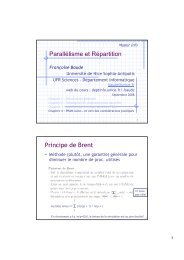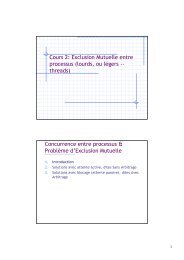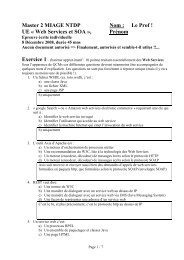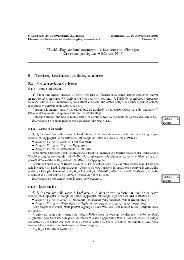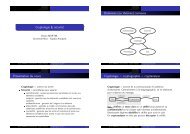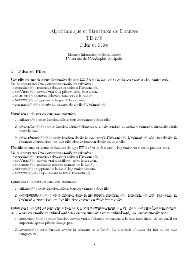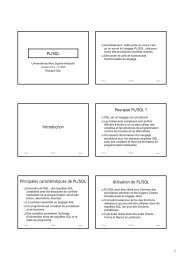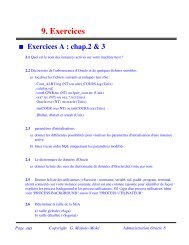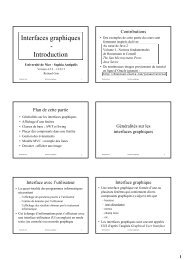TikZ and pgf
TikZ and pgf
TikZ and pgf
Create successful ePaper yourself
Turn your PDF publications into a flip-book with our unique Google optimized e-Paper software.
4 Guidelines on Graphics<br />
The present section is not about <strong>pgf</strong> or <strong>TikZ</strong>, but about general guidelines <strong>and</strong> principles concerning the<br />
creation of graphics for scientific presentations, papers, <strong>and</strong> books.<br />
The guidelines in this section come from different sources. Many of them are just what I would like to<br />
claim is “common sense,” some reflect my personal experience (though, hopefully, not my personal preferences),<br />
some come from books (the bibliography is still missing, sorry) on graphic design <strong>and</strong> typography.<br />
The most influential source are the brilliant books by Edward Tufte. While I do not agree with everything<br />
written in these books, many of Tufte’s arguments are so convincing that I decided to repeat them in the<br />
following guidelines.<br />
4.1 Should You Follow Guidelines?<br />
The first thing you should ask yourself when someone presents a bunch of guidelines is: Should I really<br />
follow these guidelines? This is an important questions, because there are good reasons not to follow general<br />
guidelines.<br />
• The person who setup the guidelines may have had other objectives than you do. For example, a<br />
guideline might say “use the color red for emphasis.” While this guideline makes perfect sense for, say,<br />
a presentation using a projector, red “color” has the opposite effect of “emphasis” when printed using<br />
a black-<strong>and</strong>-white printer.<br />
Guidelines were almost always setup to address a specific situation. If you are not in this situation,<br />
following a guideline can do more harm than good.<br />
• The basic rule of typography is: “Every rule can be broken, as long as you are aware that you are<br />
breaking a rule.” This rule also applies to graphics. Phrased differently, the basic rule states: “The<br />
only mistakes in typography are things done is ignorance.”<br />
When you are aware of a rule <strong>and</strong> when you decide that breaking the rule has a desirable effect, break<br />
the rule.<br />
• Some guidelines are simply wrong, but everyone follows them out of tradition or is forced to do so.<br />
My favorite example is a guideline a software company I used to work for has set in a big project:<br />
All programmers had to declare the parameters of functions in increasing order of size. So, one-byte<br />
parameters should come first, then two-byte parameters, <strong>and</strong> so on.<br />
This guideline is total nonsense. An (arguably) sensible guideline is “parameters must be declared<br />
alphabetically” so that parameters are easier to find. Another (arguably) sensible guideline is “parameters<br />
must be declared in decreasing order of size” so that less byte-alignment cache misses occur when<br />
the stack is accessed. The guideline the company used maximized cache misses <strong>and</strong> resulted in a more<br />
or less r<strong>and</strong>om ordering so that programmers constantly had to look up the parameter ordering.<br />
So, before you apply a guideline or choose not to apply it, ask yourself these questions:<br />
1. Does this guideline really address my situation?<br />
2. If you do the opposite a guideline says you should do, will the advantages outweigh the disadvantages<br />
this guideline was supposed to prevent?<br />
4.2 Planning the Time Needed for the Creation of Graphics<br />
When you create a paper with numerous graphics, the time needed to create these graphics becomes an<br />
important factor. How much time should you calculate for the creation of graphics?<br />
As a general rule, assume that a graphic will need as much time to create as would a text of the same<br />
length. For example, when I write a paper, I need about one hour per page for the first draft. Later, I<br />
need between two <strong>and</strong> four hours per page for revisions. Thus, I expect to need about half an hour for the<br />
creation of a first draft of a half page graphic. Later on, I expect another one to two hours before the final<br />
graphic is finished.<br />
In many publications, even in good journals, the authors <strong>and</strong> editors have obviously invested a lot of time<br />
on the text, but seem to have spend about five minutes to create all of the graphics. Graphics often seem to<br />
have been added as an “afterthought” or look like a screen shot of whatever the authors’s statistical software<br />
38






